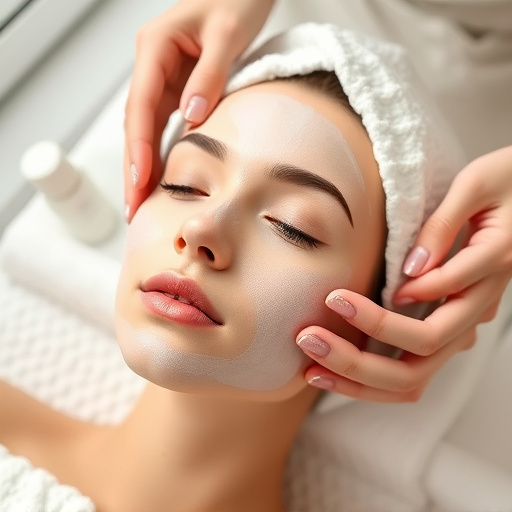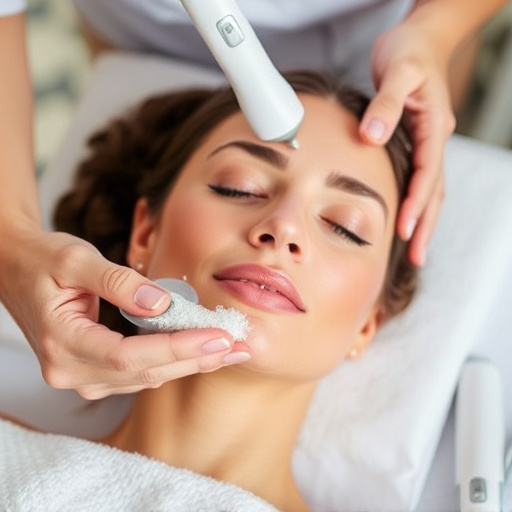Unleash Radiance: Vitamin C Facial Benefits for Glowing Skin
A Vitamin C facial is a revolutionary skincare treatment utilizing the antioxidant properties of Vit…….
Welcome to an in-depth exploration of the vibrant and transformative world of the Vitamin C Facial, a skincare ritual that has captured the attention of dermatologists, beauty enthusiasts, and influencers alike. This article aims to be your comprehensive guide, taking you on a journey from understanding the basics to uncovering the global impact, economic insights, technological innovations, regulatory aspects, and the future potential of this powerful skin-care treatment. By delving into these various facets, we will reveal why Vitamin C Facials have become a game-changer in the skincare industry and how they continue to evolve.
Definition: Vitamin C Facial, also known as ascorbic acid facial or antioxidant facial therapy, is an advanced skincare procedure that involves topically applying concentrated vitamin C solutions directly onto the face. This powerful antioxidant treatment aims to deliver a myriad of benefits to various skin types and concerns.
Core Components: The essence of this facial lies in its core components:
Vitamin C (Ascorbic Acid): Ascorbic acid is a form of vitamin C known for its exceptional ability to neutralize free radicals, boost collagen production, and even out skin tone. It is a key player in anti-aging skincare due to its role in promoting skin elasticity and reducing the appearance of fine lines and wrinkles.
Active Ingredients: Beyond vitamin C, these facials often incorporate other active ingredients such as hyaluronic acid for hydration, niacinamide for brightening, and various peptides or plant extracts to enhance specific effects like anti-inflammatory properties or enhanced collagen synthesis.
Application Methods: The treatment can be delivered through different methods, including serums, masks, or even intravenous infusions (for more intensive treatments). The concentration and form of vitamin C may vary depending on the desired outcome and skin tolerance.
Historical Context: While Vitamin C has been recognized for its health benefits since ancient times, its use in skincare is a relatively modern development. Early studies in dermatology explored the effects of ascorbic acid on various skin conditions, leading to its eventual integration into cosmetic formulations. The concept of a dedicated “facial” utilizing concentrated vitamin C solutions emerged from advancements in cosmetic science and a growing demand for effective anti-aging treatments.
The Vitamin C Facial has left an indelible mark on the global skincare landscape, captivating consumers and professionals worldwide. Here’s a glimpse into its international influence and shaping trends:
| Region | Trending Applications | Key Factors Driving Popularity |
|---|---|---|
| North America | High-concentration vitamin C serums, personalized at-home treatments | Early adoption of skincare innovations, high disposable income, celebrity endorsements |
| Europe | Integrative medicine approach, IV vitamin C infusions for intensive rejuvenation | Stricter regulations, focus on natural and scientifically proven ingredients |
| Asia Pacific | Multifunctional skincare products, innovative delivery systems (e.g., patches) | High demand for anti-aging treatments, increasing disposable income, cultural emphasis on skincare |
| Middle East | Luxurious spa experiences, gold and diamond-infused vitamin C products | Expanding luxury market, unique ingredient combinations, focus on wellness tourism |
The global skincare market, valued at USD 172.6 billion in 2021 (and projected to grow), witnesses a surge in demand for anti-aging treatments, driving the popularity of Vitamin C Facials. The trend towards personalized, high-tech skincare solutions further fuels its success across diverse regions.
The economic aspects of Vitamin C Facials offer a compelling narrative of market growth, investment trends, and their role in global economic systems.
Market Dynamics:
Investment Patterns:
Economic System Integration:
Technology plays a pivotal role in enhancing the effectiveness and accessibility of Vitamin C Facials, opening doors to innovative delivery methods and formulations.
Breakthrough Deliveries:
Digital Skin Analysis: The integration of artificial intelligence (AI) and digital skin analysis tools enables personalized skincare routines, including tailored Vitamin C Facial protocols. These technologies assess skin conditions and provide customized product recommendations.
Research Frontiers: Ongoing research explores new derivatives of vitamin C, such as stable forms with extended release profiles, to optimize treatment outcomes further. Additionally, combining vitamin C with other antioxidants or targeted therapies holds promise for addressing specific skin concerns.
The regulatory environment surrounding Vitamin C Facials is crucial in ensuring product safety, quality, and consumer protection. Different regions have varying approaches to governing skincare treatments.
Key Regulatory Bodies and Guidelines:
Key Considerations:
Despite its numerous benefits, the Vitamin C Facial has faced challenges and criticisms that require thoughtful consideration and strategic solutions.
Common Challenges:
Criticisms and Strategies:
Let’s delve into a few case studies that highlight the transformative power of Vitamin C Facials and the lessons learned from these successful applications.
Case Study 1: Acne-Prone Skin Restoration
Patient Profile: Sarah, 28, struggled with moderate acne and post-inflammatory hyperpigmentation. She sought a non-invasive solution to improve her skin’s overall appearance.
Treatment Approach: A series of Vitamin C Facials was recommended, combining high-concentration serum treatments with targeted topicals for acne management.
Outcomes: After 12 weeks, Sarah observed significant improvements in her skin’s clarity and tone. The treatment reduced acne lesions and evened out skin pigmentation, leading to increased confidence and a more positive self-image.
Key Takeaway: Vitamin C Facials can effectively address various skin concerns, offering a non-invasive alternative for individuals seeking improvement in skin quality and appearance.
Case Study 2: Anti-Aging Transformation
Client Profile: David, 45, expressed concern about fine lines and wrinkles around his eyes and forehead. He sought a preventative skincare strategy to maintain a youthful appearance.
Treatment Plan: A customized Vitamin C Facial routine was designed, focusing on intense hydration and collagen stimulation. The regimen included weekly facials and daily at-home care instructions.
Results: After 6 months, David noticed a noticeable reduction in fine lines and an improvement in skin elasticity. His skin appeared brighter, more radiant, and gained a healthy glow, surpassing his expectations.
Lessons Learned: Consistency is key to achieving long-lasting results with Vitamin C Facials. Regular treatments and adherence to home care routines significantly enhance overall effectiveness.
As we peer into the future, several trends and potential growth areas emerge for Vitamin C Facials, shaping their role in the ever-evolving skincare industry.
Emerging Trends:
Growth Areas:
Strategic Considerations:
The Vitamin C Facial has emerged as a powerful tool in the pursuit of radiant, healthy skin. From its historical roots to its global impact, technological innovations, and regulatory considerations, this skincare ritual has captivated professionals and enthusiasts alike. By addressing various skin concerns and offering both short-term and long-term benefits, Vitamin C Facials continue to evolve and adapt to meet the diverse needs of consumers worldwide.
As we look ahead, the future holds immense potential for this transformative treatment, with personalized care, technological advancements, and a heightened focus on sustainability shaping its trajectory. By embracing these developments and addressing challenges head-on, the Vitamin C Facial is poised to remain at the forefront of skincare innovation, empowering individuals to unlock their skin’s true radiance.
Q1: Are Vitamin C Facials suitable for all skin types?
A: While vitamin C is generally well-tolerated, it may cause irritation in individuals with sensitive or acne-prone skin. Patch testing and consulting a dermatologist are recommended before trying any new treatment.
Q2: How often should I get a Vitamin C Facial?
A: The frequency depends on your skin’s response and the specific treatment goals. For anti-aging, once weekly for 4-6 weeks, followed by maintenance every 2-3 months, is common. For acne or hyperpigmentation, more frequent treatments (e.g., biweekly) may be advised.
Q3: Can Vitamin C Facials cure skin conditions like eczema or psoriasis?
A: Vitamin C Facials are not a cure for chronic skin conditions. However, they can help improve skin clarity and reduce inflammation. For severe cases, consulting a dermatologist is essential for appropriate treatment.
Q4: Are there any at-home alternatives to Vitamin C Facials?
A: Absolutely! At-home vitamin C serums and skincare products offer a more affordable way to incorporate the benefits of vitamin C into your routine. Look for stable, high-quality formulations with appropriate preservatives.
Q5: How do I know if a Vitamin C Facial product is effective?
A: Effective products should be formulated with stable, high-quality vitamin C and deliverable in a suitable vehicle. Clinical studies or independent reviews can provide valuable insights into a product’s efficacy.

A Vitamin C facial is a revolutionary skincare treatment utilizing the antioxidant properties of Vit…….

A Vitamin C facial offers multiple benefits, including protection against environmental damage, coll…….